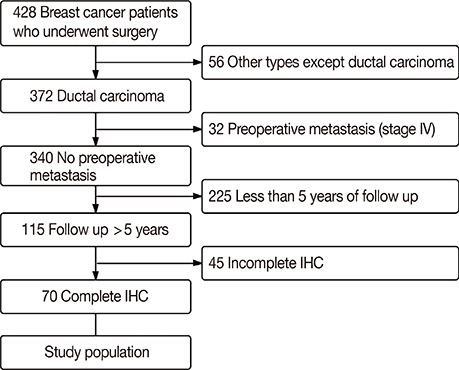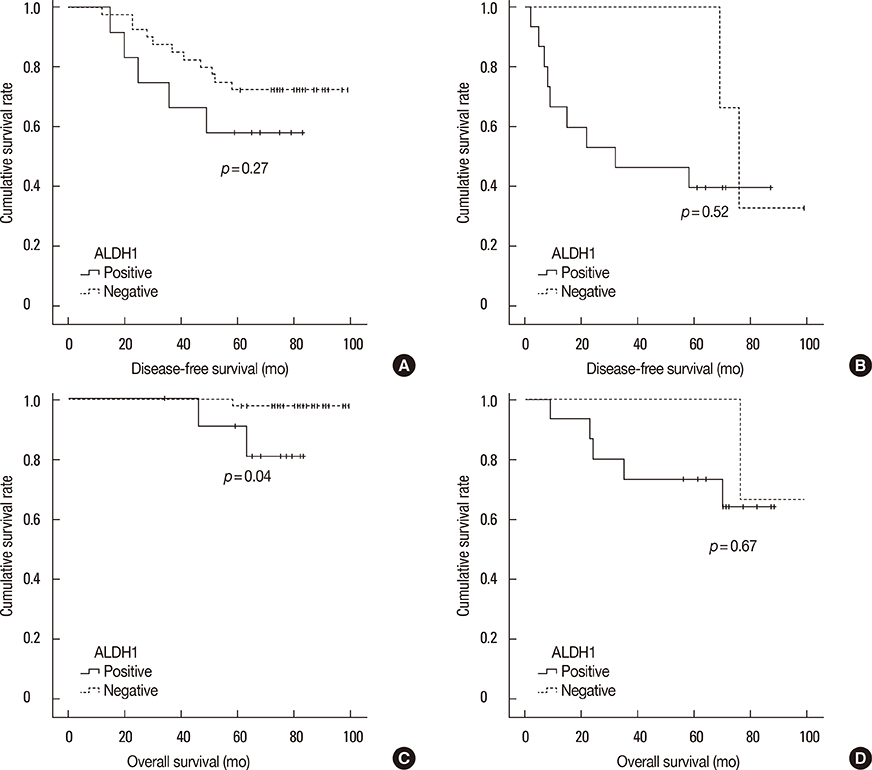J Breast Cancer.
2014 Jun;17(2):121-128.
Clinicopathologic Characteristics of Breast Cancer Stem Cells Identified on the Basis of Aldehyde Dehydrogenase 1 Expression
- Affiliations
-
- 1Department of Surgery, Kosin University Gospel Hospital, Busan, Korea. mammomaster@naver.com
- 2Department of Pathology, Kosin University Gospel Hospital, Busan, Korea.
Abstract
- PURPOSE
Breast cancer displays varying molecular and clinical features. The ability to form breast tumors has been shown by several studies with aldehyde dehydrogenase 1 (ALDH1) positive cells. The aim of this study is to investigate the association between ALDH1 expression and clinicopathologic characteristics of invasive ductal carcinoma.
METHODS
We investigated breast cancer tissues for the prevalence of ALDH1+ tumor cells and their prognostic value. The present study included paraffin-embedded tissues of 70 patients with or without recurrences. We applied immunohistochemical staining for the detection of ALDH1+ cells. Analysis of the association of clinical outcomes and molecular subtype with marker status was conducted.
RESULTS
ALDH1+ and ALDH1- tumors were more frequent in triple-negative breast cancers and in luminal A breast cancers, respectively (p<0.01). ALDH1 expression was found to exert significant impact on disease free survival (DFS) (ALDH1+ vs. ALDH1-, 53.1+/-6.7 months vs. 79.2+/-4.7 months; p=0.03) and overall survival (OS) (ALDH1+ vs. ALDH1-, 68.5+/-4.7 months vs. 95.3+/-1.1 months; p<0.01). In triple-negative breast cancer (TNBC) patients, DFS and OS showed no statistical differences according to ALDH1 expression (ALDH1+ vs. ALDH1-, 45.3+/-9.4 months vs. 81.3+/-7.4 months, p=0.52; 69.0+/-7.5 months vs. 91.3+/-6.3 months, p=0.67). However, non-TNBC patients showed significant OS difference between ALDH1+ and ALDH1- tumors (ALDH1+ vs. ALDH1-, 77.6+/-3.6 months vs. 98.0+/-1.0 months; p=0.04) with no statistical difference of DFS (ALDH1+ vs. ALDH1-, 60.5+/-8.0 months vs. 81.8+/-4.6 months; p=0.27).
CONCLUSION
Our findings suggest that the expression of ALDH1 in breast cancer may be associated with TNBC and poor clinical outcomes. On the basis of our findings, we propose that ALDH1 expression in breast cancer could be correlated with poor prognosis, and may contribute to a more aggressive cancer phenotype.
MeSH Terms
Figure
Reference
-
1. Sung JY, Kim GY, Park YK, Lee J, Kim YW, Lim SJ. Clinicopathological significance of invasive ductal carcinoma with high prevalence of CD44(+)/CD24(-/low) tumor cells in breast cancer. Korean J Pathol. 2010; 44:390–396.
Article2. de Beça FF, Caetano P, Gerhard R, Alvarenga CA, Gomes M, Paredes J, et al. Cancer stem cells markers CD44, CD24 and ALDH1 in breast cancer special histological types. J Clin Pathol. 2013; 66:187–191.
Article3. Park SY, Lee HE, Li H, Shipitsin M, Gelman R, Polyak K. Heterogeneity for stem cell-related markers according to tumor subtype and histologic stage in breast cancer. Clin Cancer Res. 2010; 16:876–887.
Article4. Jordan CT, Guzman ML, Noble M. Cancer stem cells. N Engl J Med. 2006; 355:1253–1261.
Article5. Neumeister V, Agarwal S, Bordeaux J, Camp RL, Rimm DL. In situ identification of putative cancer stem cells by multiplexing ALDH1, CD44, and cytokeratin identifies breast cancer patients with poor prognosis. Am J Pathol. 2010; 176:2131–2138.
Article6. Idowu MO, Kmieciak M, Dumur C, Burton RS, Grimes MM, Powers CN, et al. CD44(+)/CD24(-/low) cancer stem/progenitor cells are more abundant in triple-negative invasive breast carcinoma phenotype and are associated with poor outcome. Hum Pathol. 2012; 43:364–373.
Article7. Lin Y, Zhong Y, Guan H, Zhang X, Sun Q. CD44+/CD24- phenotype contributes to malignant relapse following surgical resection and chemotherapy in patients with invasive ductal carcinoma. J Exp Clin Cancer Res. 2012; 31:59.
Article8. Currie MJ, Beardsley BE, Harris GC, Gunningham SP, Dachs GU, Dijkstra B, et al. Immunohistochemical analysis of cancer stem cell markers in invasive breast carcinoma and associated ductal carcinoma in situ: relationships with markers of tumor hypoxia and microvascularity. Hum Pathol. 2013; 44:402–411.
Article9. Mylona E, Giannopoulou I, Fasomytakis E, Nomikos A, Magkou C, Bakarakos P, et al. The clinicopathologic and prognostic significance of CD44+/CD24(-/low) and CD44-/CD24+ tumor cells in invasive breast carcinomas. Hum Pathol. 2008; 39:1096–1102.
Article10. Bane A, Viloria-Petit A, Pinnaduwage D, Mulligan AM, O'Malley FP, Andrulis IL. Clinical-pathologic significance of cancer stem cell marker expression in familial breast cancers. Breast Cancer Res Treat. 2013; 140:195–205.
Article11. Perrone G, Gaeta LM, Zagami M, Nasorri F, Coppola R, Borzomati D, et al. In situ identification of CD44+/CD24- cancer cells in primary human breast carcinomas. PLoS One. 2012; 7:e43110.
Article12. Sheridan C, Kishimoto H, Fuchs RK, Mehrotra S, Bhat-Nakshatri P, Turner CH, et al. CD44+/CD24- breast cancer cells exhibit enhanced invasive properties: an early step necessary for metastasis. Breast Cancer Res. 2006; 8:R59.13. Sun H, Jia J, Wang X, Ma B, Di L, Song G, et al. CD44+/CD24- breast cancer cells isolated from MCF-7 cultures exhibit enhanced angiogenic properties. Clin Transl Oncol. 2013; 15:46–54.
Article14. Guler G, Balci S, Costinean S, Ussakli CH, Irkkan C, Suren D, et al. Stem cell-related markers in primary breast cancers and associated metastatic lesions. Mod Pathol. 2012; 25:949–955.
Article15. Douville J, Beaulieu R, Balicki D. ALDH1 as a functional marker of cancer stem and progenitor cells. Stem Cells Dev. 2009; 18:17–25.
Article16. Al-Hajj M, Wicha MS, Benito-Hernandez A, Morrison SJ, Clarke MF. Prospective identification of tumorigenic breast cancer cells. Proc Natl Acad Sci U S A. 2003; 100:3983–3988.
Article17. Ginestier C, Hur MH, Charafe-Jauffret E, Monville F, Dutcher J, Brown M, et al. ALDH1 is a marker of normal and malignant human mammary stem cells and a predictor of poor clinical outcome. Cell Stem Cell. 2007; 1:555–567.
Article18. Allred DC, Harvey JM, Berardo M, Clark GM. Prognostic and predictive factors in breast cancer by immunohistochemical analysis. Mod Pathol. 1998; 11:155–168.19. Reya T, Morrison SJ, Clarke MF, Weissman IL. Stem cells, cancer, and cancer stem cells. Nature. 2001; 414:105–111.
Article20. Takahashi RU, Takeshita F, Fujiwara T, Ono M, Ochiya T. Cancer stem cells in breast cancer. Cancers (Basel). 2011; 3:1311–1328.
Article21. Ricardo S, Vieira AF, Gerhard R, Leitão D, Pinto R, Cameselle-Teijeiro JF, et al. Breast cancer stem cell markers CD44, CD24 and ALDH1: expression distribution within intrinsic molecular subtype. J Clin Pathol. 2011; 64:937–946.
Article22. Sorlie T, Perou CM, Tibshirani R, Aas T, Geisler S, Johnsen H, et al. Gene expression patterns of breast carcinomas distinguish tumor subclasses with clinical implications. Proc Natl Acad Sci U S A. 2001; 98:10869–10874.
Article23. Sorlie T, Tibshirani R, Parker J, Hastie T, Marron JS, Nobel A, et al. Repeated observation of breast tumor subtypes in independent gene expression data sets. Proc Natl Acad Sci U S A. 2003; 100:8418–8423.
Article24. Honeth G, Bendahl PO, Ringnér M, Saal LH, Gruvberger-Saal SK, Lövgren K, et al. The CD44+/CD24- phenotype is enriched in basal-like breast tumors. Breast Cancer Res. 2008; 10:R53.25. Tanei T, Morimoto K, Shimazu K, Kim SJ, Tanji Y, Taguchi T, et al. Association of breast cancer stem cells identified by aldehyde dehydrogenase 1 expression with resistance to sequential paclitaxel and epirubicin-based chemotherapy for breast cancers. Clin Cancer Res. 2009; 15:4234–4241.
Article
- Full Text Links
- Actions
-
Cited
- CITED
-
- Close
- Share
- Similar articles
-
- Erratum: Clinicopathologic Characteristics of Breast Cancer Stem Cells Identified on the Basis of Aldehyde Dehydrogenase 1 Expression
- Inhibitor of DNA-binding 4 contributes to the maintenance and expansion of cancer stem cells in 4T1 mouse mammary cancer cell line
- The Expression of Aldehyde Dehydrogenase Family in Breast Cancer
- Effective Keratocyte Culture Using Amniotic Membrane Matrix and Differentiation of Mesenchymal Stem Cells
- OCT4 Expression Enhances Features of Cancer Stem Cells in a Mouse Model of Breast Cancer





